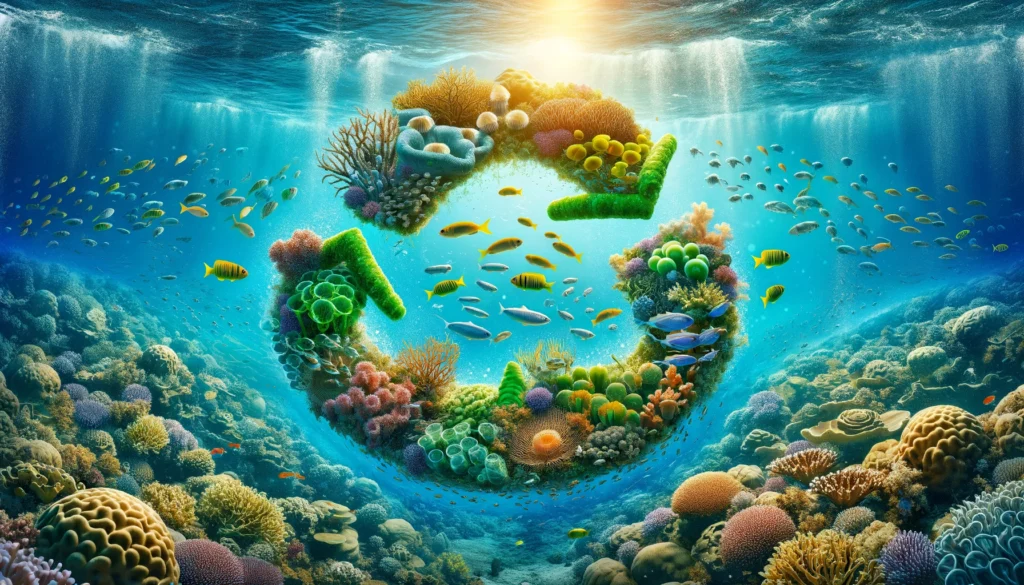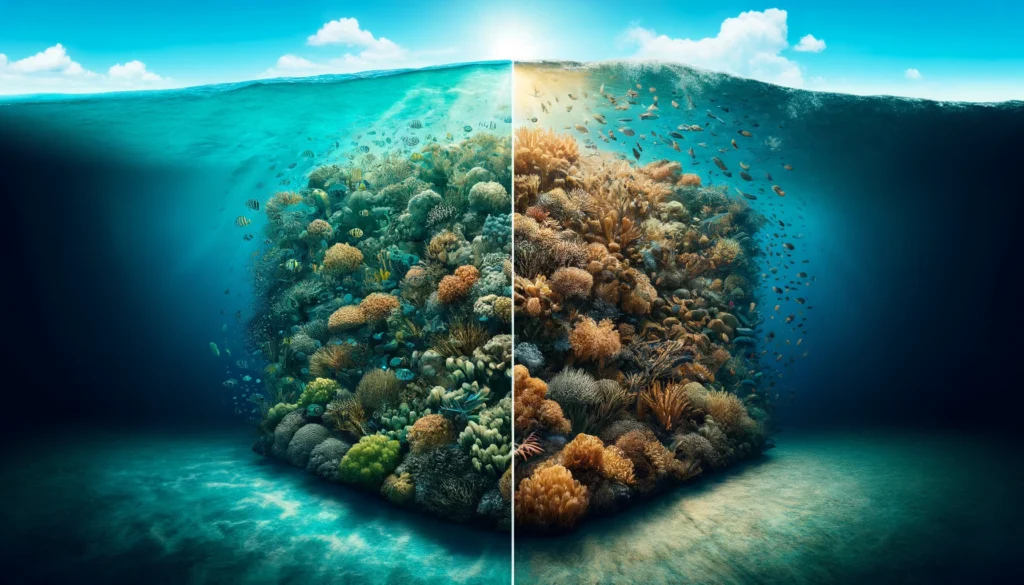Coral reefs, often celebrated as the rainforests of the sea, are among the most vibrant and diverse ecosystems on our planet. They provide shelter, food, and breeding grounds for an astonishing array of marine life, supporting an estimated 25% of all marine species. Yet, the foundational role of a lesser-known protagonist within this underwater paradise remains largely overshadowed: cyanobacteria. These microscopic organisms, colloquially known as blue-green algae, are not just passive inhabitants of the reef; they are its master builders and sustainers.
Cyanobacteria are more than just a thread in the complex tapestry of coral reef ecosystems; they are the weavers themselves, playing a crucial role in the creation and maintenance of the reef structure. Through their unique abilities, they contribute significantly to the calcification process that forms the very backbone of coral reefs. Beyond their architectural feats, these tiny organisms are vital players in the ecological balance, influencing the health and productivity of the entire reef community. As we dive into the secret world of cyanobacteria, we uncover a fascinating narrative of symbiosis, resilience, and the subtle yet profound influence of these microorganisms on the grandeur of coral reefs.
Unveiling Cyanobacteria: The Ancient Alchemists of the Sea
Cyanobacteria, also known as blue-green algae, are among the oldest and most resilient organisms on Earth. These microscopic life forms are not true algae but bacteria capable of photosynthesis, blurring the lines between plant and bacterial kingdoms. Their unique characteristics and ancient lineage make them a fascinating subject of study in the biological world.

- Ancient Microbial Architects
Cyanobacteria have a storied history that dates back over 2.5 billion years, making them some of the earliest inhabitants of our planet. They played a crucial role in transforming the Earth’s atmosphere and environment through the release of oxygen via photosynthesis. This monumental process, known as the Great Oxygenation Event, was pivotal in the evolution of life, leading to the rise of aerobic organisms and the complex ecosystems we see today.
- Diversity and Adaptability
Boasting a wide range of shapes, sizes, and colors, cyanobacteria are found in almost every terrestrial and aquatic habitat. From hot springs to frozen tundras, from oceans to freshwater lakes, they thrive in diverse conditions, showcasing their remarkable adaptability. Some cyanobacteria are free-living, while others form symbiotic relationships with plants, fungi, and animals, demonstrating their ecological versatility.
- Photosynthesis Pioneers
Cyanobacteria are distinguished by their ability to perform oxygenic photosynthesis, a trait they share with plants and algae. They harness sunlight to convert carbon dioxide and water into glucose and oxygen, thus sustaining themselves and contributing to the atmospheric oxygen. This process not only fuels their survival but also supports a vast array of life forms dependent on their photosynthetic productivity.
Architects of the Ocean: Cyanobacteria and Coral Reefs
Cyanobacteria are not merely inhabitants of the ocean; they are foundational to its most biodiverse ecosystems, the coral reefs. These microorganisms are the unsung heroes, playing a critical role in constructing and maintaining the reef’s infrastructure.
- Building Blocks of the Reef
At the core of their architectural prowess is the ability of cyanobacteria to produce calcium carbonate, a key component of coral skeletons. Through a process known as biomineralization, they contribute to the formation of reef structures, creating a sturdy base for coral polyps to anchor and grow. This symbiotic relationship between cyanobacteria and corals is vital, as it forms the backbone of the reef ecosystem, supporting a wide array of marine life.

- Symbiotic Partnerships
Beyond their structural contributions, cyanobacteria are integral to the nutrient cycling within coral reefs. They engage in symbiotic relationships with various reef organisms, providing essential nutrients in exchange for protection and sustenance. For instance, some cyanobacteria live within the tissues of corals, supplying them with energy through photosynthesis and helping them to thrive in nutrient-poor waters. This partnership is crucial for the health and growth of coral colonies, influencing the overall productivity and stability of the reef ecosystem.
- A Delicate Balance
The relationship between cyanobacteria and coral reefs is a delicate balance. While they are essential for the health of the reef, an overabundance of cyanobacteria can be detrimental. Factors like pollution and climate change can lead to cyanobacterial blooms, smothering corals, and disrupting the delicate ecological balance. Thus, understanding and preserving the role of cyanobacteria in coral reefs is essential for maintaining the health and diversity of these underwater wonders.
Sustaining the Coral Sanctuary
Cyanobacteria are more than just passive residents of coral reefs; they are active contributors to the health and stability of these marine ecosystems. Their role in coral health is multifaceted, ranging from nutrient cycling to providing essential services that support the entire reef community.
- Nutrient Cyclers of the Reef
One of the key functions of cyanobacteria in coral reef ecosystems is their role in nutrient cycling. These microorganisms are adept at converting nitrogen from the atmosphere or water into forms that are usable by other reef organisms, a process known as nitrogen fixation. This ability makes cyanobacteria crucial in maintaining the nutrient balance within coral reefs, where nutrient levels are often low but productivity is high. By enriching their environment with essential nutrients, they ensure that life flourishes, supporting a diverse array of marine species.

- A Delicate Balance
While cyanobacteria are essential for nutrient cycling, their abundance must be kept in check. An overgrowth of cyanobacteria, often spurred by pollution or changes in water quality, can lead to harmful algal blooms that threaten coral health. These blooms can smother coral reefs, blocking light and depleting oxygen in the water, which can lead to coral bleaching and even death. Monitoring and managing cyanobacterial populations are therefore crucial for maintaining the delicate balance of reef ecosystems.
- Partners in Symbiosis
Beyond nutrient cycling, some cyanobacteria form symbiotic relationships with corals, living in their tissues and contributing to the coral’s energy needs through photosynthesis. This partnership highlights the intricate connections within reef ecosystems, where even the smallest organisms play significant roles in the survival and prosperity of their larger counterparts.
Facing the Threats: Cyanobacteria and Coral Reefs in Peril
The delicate balance of coral reef ecosystems, with cyanobacteria playing a fundamental role, faces unprecedented threats from human activities and climate change. The very survival of these underwater communities hinges on addressing these challenges and implementing effective conservation strategies.
- Climate Change: A Growing Menace
Global warming poses a significant threat to coral reefs and the cyanobacteria that support them. Rising sea temperatures can lead to coral bleaching, where corals expel the symbiotic algae living in their tissues, including photosynthetic cyanobacteria, leading to a decline in nutrient availability and reef health. Additionally, ocean acidification, a byproduct of increased CO2 levels, hampers the ability of corals and cyanobacteria to calcify, weakening the reef structure.

- Pollution and Overexploitation
Human-induced pollution, such as runoff containing pesticides, heavy metals, and other toxins, can drastically alter the balance of marine ecosystems, affecting both corals and cyanobacteria. Nutrient pollution, particularly from agricultural runoff, can encourage harmful algal blooms, including the overgrowth of certain cyanobacteria species, which can outcompete and smother coral reefs. Overfishing and destructive fishing practices further exacerbate the stress on coral ecosystems, disrupting the intricate web of life that includes cyanobacteria.
- The Path to Conservation
Conserving cyanobacteria and coral reefs requires a multifaceted approach. Protecting marine areas, regulating fishing activities, reducing pollution, and mitigating climate change are critical steps. Research and monitoring programs can help understand the complex interactions within reef ecosystems and the impact of environmental changes. Public education and community involvement are also vital in fostering stewardship and supporting conservation efforts.
Conclusion
The journey into the world of cyanobacteria and their pivotal role in sustaining coral reef ecosystems reveals a narrative of interdependence and resilience. These microscopic organisms, often overlooked, are fundamental architects of the ocean’s wonderland, shaping the very existence of coral reefs. Their ability to transform sunlight into life-sustaining energy, fix essential nutrients, and build complex structures highlights their significance in marine biodiversity. However, the fragility of this relationship is evident as environmental pressures mount, threatening the delicate balance of reef ecosystems.
Understanding the dual nature of cyanobacteria—as both vital supporters and potential threats—underscores the importance of holistic approaches in marine conservation. Protecting these ancient microbial engineers is not just about preserving a single species, but about safeguarding an entire ecosystem that is crucial for the planet’s biological diversity and human welfare.

Author’s Note
As an enthusiast of marine life and ecosystems, writing this blog has been a journey of discovery into the microscopic world that holds colossal importance in our oceans. Cyanobacteria, these ancient and resilient organisms, are more than just a component of coral reefs; they are the unsung heroes shaping the marine environment. I hope this exploration enlightens and inspires as much as it has for me, highlighting the intricate connections and the urgent need for conservation in our oceanic realms.
G.C., Ecosociosphere contributor.
References and Further Reading
- “Microbial Ecology of the Oceans” by David L. Kirchman – This book delves into the role of microorganisms, including cyanobacteria, in ocean ecosystems, providing insights into their ecological functions and interactions.
- “Coral Reefs in the Microbial Seas” by Forest Rohwer – An in-depth look at the complex microbial interactions within coral reef ecosystems, including the role of cyanobacteria.
- “The Ecology of Cyanobacteria: Their Diversity in Time and Space” by Brian A. Whitton and Malcolm Potts – An in-depth look at cyanobacteria, examining their diversity, ecology, and the role they have played in the environment over geological time scales.





Comments
Thanks for sharing. I read many of your blog posts, cool, your blog is very good.
Thanks for sharing. I read many of your blog posts, cool, your blog is very good.